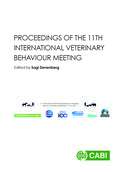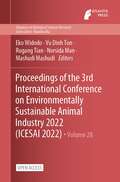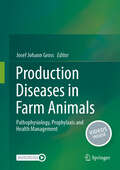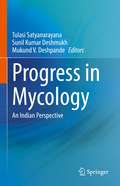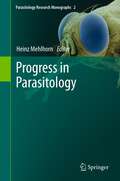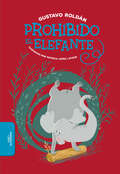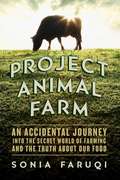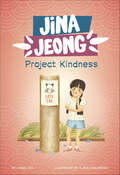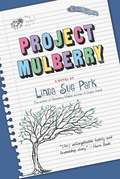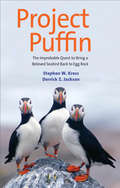- Table View
- List View
Proceedings of the 11th International Veterinary Behaviour Meeting
by Dr Sagi DenenbergThis book contains the proceedings from the 11th International Veterinary Behaviour Meeting. Keynote Presentations include 'Use of Psychopharmacology to Reduce Anxiety and Fear in Dogs and Cats: A Practical Approach' by Barbara L. Sherman, 'A Multimodal Approach to Resolving Tension Between Cats in the Same Household: A Practical Approach' by Sarah E. Heath, 'The Importance of the Welfare of Research Animals to Maximise the Quality of Behavioural Research: Do We Measure True Behaviours?' by Patrick Pageat and 'Making Animal Welfare Sustainable - Human Behaviour Change for Animal Behaviour: The Human Element' by Jo White and Suzanne Rogers.
Proceedings of the 11th International Veterinary Behaviour Meeting
by Sagi DenenbergThis book contains the proceedings from the 11th International Veterinary Behaviour Meeting. Keynote Presentations include 'Use of Psychopharmacology to Reduce Anxiety and Fear in Dogs and Cats: A Practical Approach' by Barbara L. Sherman, 'A Multimodal Approach to Resolving Tension Between Cats in the Same Household: A Practical Approach' by Sarah E. Heath, 'The Importance of the Welfare of Research Animals to Maximise the Quality of Behavioural Research: Do We Measure True Behaviours?' by Patrick Pageat and 'Making Animal Welfare Sustainable - Human Behaviour Change for Animal Behaviour: The Human Element' by Jo White and Suzanne Rogers.
Proceedings of the 3rd International Conference on Environmentally Sustainable Animal Industry 2022 (Advances in Biological Sciences Research #28)
by Eko Widodo Vu Dinh Ton Rugang Tian Norsida Man Mashudi MashudiThis is an open access book.The 3rd ICESAI aims to discuss issues related to the development of an eco-friendly and sustainable livestock industry using smart farming which is related to scientific research and how it is applied. The 3rd ICESAI offers opportunities for the for researchers and the livestock industry from all over the world to share experiences, learn and expand networking on several matters relating to the development of a sustainable and environmentally friendly livestock industry, especially with the implementation of smart farming.
Proceedings of the 4th International Conference on Life Sciences and Biotechnology (Advances in Biological Sciences Research #27)
by Bambang SugihartoThis is an open access book.We are pleased to invite you to participate in the 4th International Confrerence on Life Sciences and Biotechnology, “Towards Sustainable Development: Application of Biosciences to Improve Welfare and Quality of Life“. The International Conference which will be held on by The Department of Biology, Faculty of Mathematics and Natural Sciences, University of Jember November 15-16, 2021.The 1st, 2nd, and 3rd ICOLIB had been successfully held in 2015, 2017, and 2019 in University of Jember, respectively. This year’s conference will be held virtually, and present some outstanding speakers coming from Indonesia, Germany, Nederland, The United States of America and South Korea.
Producing Predators: Wolves, Work, and Conquest in the Northern Rockies
by Michael D. WiseIn Producing Predators, Michael D. Wise argues that contestations between Native and non-Native people over hunting, labor, and the livestock industry drove the development of predator eradication programs in Montana and Alberta from the 1880s onward. The history of these anti-predator programs was significant not only for their ecological effects, but also for their enduring cultural legacies of colonialism in the Northern Rockies. By targeting wolves and other wild carnivores for extermination, cattle ranchers disavowed the predatory labor of raising domestic animals for slaughter, representing it instead as productive work. Meanwhile, federal agencies sought to purge the Blackfoot, Salish-Kootenai, and other indigenous peoples of their so-called predatory behaviors through campaigns of assimilation and citizenship that forcefully privatized tribal land and criminalized hunting and its related ritual practices. Despite these colonial pressures, Native communities resisted and negotiated the terms of their dispossession by representing their own patterns of work, food, and livelihood as productive. By exploring predation and production as fluid cultural logics for valuing labor, rather than just a set of biological processes, Producing Predators offers a new perspective on the history of the American West and the modern history of colonialism more broadly.
Production Diseases in Farm Animals: Pathophysiology, Prophylaxis and Health Management
by Josef Johann GrossThis textbook deals comprehensively with livestock production diseases and their prevention in the major species: ruminants, swine, and poultry. It gives an interdisciplinary view on pathophysiology, prophylaxis, and health management.Livestock breeding and husbandry is often accompanied by a conflict of interest between the animal´s biological requirements and economic producer needs. This conflict is increasingly gaining attention not only by producers, animal scientists, and veterinarians, but also by the public. It creates significant future challenges, which are described and addressed in this book. The main topics covered are: • the use of antimicrobials with emphasis on security and safety for producers/consumers• the impact of locomotion disorders on performance and welfare of farm animals • the interactions of gut microbiome, genetics, climate change, metabolic status and mineral homeostasis with reproduction, performance, animal health and welfare• infectious and respiratory diseases• the raising of neonatesA special section is devoted to behavioural signs indicating an impaired animal welfare. These are the basis for precision livestock farming (PLF) technology and the development of new management concepts. The present work is a valuable resource for veterinarians, students, as well as expert readers from animal and agricultural sciences, food safety and technology. Supplementary videos can be accessed online as well as directly from the print book; simply download the Springer Nature More Media App for free and scan the links with the play button.
Productive Safety Management: A Strategic, Multi-disciplinary Management System For Hazardous Industries That Ties Safety And Production Together
by Tania MolUnlike most books on this subject, Productive Safety Management, described in this book, integrates occupational health and safety, human resource management, environmental management, and engineering to provide a whole-business approach to effective safety management.The book helps companies to reduce and manage risk by providing, analysing and improving systems in place within the company. It also looks at how external factors can affect company decision making and provides a tool to make sure that a health and safety management system is strategically aligned, appropriately resourced, and that it maximises employee commitment. Chapters on human resource management explore cultural issues and explain how to gain commitment to company objectives.The book has been written for managers and supervisors working in hazardous industries, OHS practitioners, undergraduate and postgraduate students.
Professional Care of the Racehorse: A Guide to Grooming, Feeding, and Handling the Equine Athlete
by T. A. LandersTaking care of a racehorse involves many facets—from keeping the horse happy to recognizing any signs of lameness to knowing how to muck a stall. Author T.A. Landers, a former master groom turned trainer, breaks down all aspects of racehorse care in a clear, concise, and comprehensive manner that will leave the reader with more confidence in handling these magnificent animals. Professional Care of the Racehorse provides photographs and detailed explanations of grooming, feeding, restraining, tacking, and handling racehorses. The book also explains the necessary equipment and its proper use and care. All of this thrown in together with a few tips on horse psychology makes it an excellent resource for anyone who works with horses.
Professional Crocodile
by Giovanna Zoboli Mariachiara Di GiorgioMr. Crocodile loves his job. Every morning he gets up with an alarm. He brushes his teeth. He chooses the right tie to match his outfit, eats a quick slice of toast, and heads off to work on a crowded train. But what exactly is his job? The answer may surprise you! Readers will want to pore over this witty, wordless book again and again, finding new details and fresh stories with every reading. Plus, this is the fixed format version, which looks almost identical to the print edition.
Professional Crocodile
by Giovanna Zoboli Mariachiara Di GiorioAn ALA Notable Book: A &“funny, surprising&” tale told though stunningly delightful artwork (The Wall Street Journal). Mr. Crocodile loves his job. Every morning he gets up with an alarm. He brushes his teeth. He chooses the right tie to match his outfit, eats a quick slice of toast, and heads off to work on a crowded train. But what exactly is his job? The answer may surprise you! Readers young and old will want to pore over this witty, wordless book again and again, finding new details and fresh stories every time.
Professionalism and Reflection in Veterinary Nursing
by Andrea Jeffery Sue BadgerProfessionalism and Reflection in Veterinary Nursing Professionalism and Reflection in Veterinary Nursing offers insight into the role of the veterinary nurse in the 21st century. It provides useful information that facilitates a deeper understanding of the underlying theory that supports clinical nursing practice. Exploring concepts that underpin the delivery of professional veterinary nursing, the book covers core issues, themes and principles that explain what it means to be a veterinary nurse. The role of the registered veterinary nurse The registered veterinary nurse’s responsibility to the patient Evidence-based veterinary nursing Veterinary nurse trainer and educator resources A timely publication due to the increased recognition and expectations of the role of the veterinary nursing profession, Professionalism and Reflection in Veterinary Nursing is ideal for veterinary student nurses and qualified veterinary nurses, enabling them to contribute to the development of the professional identity.
Professor Goose Debunks Goldilocks and the Three Bears (Professor Goose Debunks Fairy Tales #1)
by Paulette BourgeoisThe first in a new series by the author of Franklin the Turtle! Join Professor Goose in this STEM-filled picture book as she fact-checks classic fairy tales and shares the science behind these flawed stories.Mother Goose's fairy tales are NOT based in science, and her great niece Professor Goose thinks it's time to share the truth. Join Professor Goose as she — literally — travels through the pages of Goldilocks and the Three Bears, fact-checking, exposing the flaws and explaining the science. Bears don't live in cottages — they prefer dens! The smallest bowl of porridge wouldn't be "just right" — it would have been the coldest! Professor Goose is delighted to see Baby Bear use the scientific method and Goldilocks's fight or flight response. And maybe Goldilocks should have used a GPS so she wouldn't have gotten lost in the first place?Jammed with jokes and wonderfully silly illustrations, this book entertains while it introduces basic scientific laws and rules to young readers. At the back of the book, readers will find Professor Goose's instructions on how to engineer their own chair for a (teddy) bear!
Professor Goose Debunks The Three Little Pigs (Professor Goose Debunks Fairy Tales #2)
by Paulette BourgeoisThe second in a fractured fairy tale series by the author of Franklin the Turtle! Join Professor Goose in this STEM-filled picture book as she fact-checks classic fairy tales and shares the science behind these flawed stories.Mother Goose's fairy tales are NOT based in science, and her great niece Professor Goose thinks it's time to share the truth. Join Professor Goose as she — literally — travels through the pages of The Three Little Pigs, fact-checking, exposing the flaws and explaining the science. Did you know that pigs run in a zigzag pattern? And that there's no way a wolf's breath would be strong enough to blow down anything, even if he has his whole pack with him? And that hay bales are strong enough to resist most up, down and sideways forces? Sounds like the perfect material for building a house! . . . Or, not. But not to worry — Professor Goose is armed with helpful hints on how to make a structure strong enough to withstand hurricane forces! Jammed with jokes and hilarious illustrations, this book entertains while it introduces basic scientific laws and rules to young readers. At the back of the book, readers will find Professor Goose's new, carefully researched fairy tale ending as well as her favorite facts about coding!
Professor Goose Debunks The Three Little Pigs (Professor Goose Debunks Fairy Tales)
by Paulette BourgeoisThe second in a fractured fairy tale series by the author of Franklin the Turtle! Join Professor Goose in this STEM-filled picture book as she fact-checks classic fairy tales and shares the science behind these flawed stories.Mother Goose's fairy tales are NOT based in science, and her great niece Professor Goose thinks it's time to share the truth. Join Professor Goose as she — literally — travels through the pages of The Three Little Pigs, fact-checking, exposing the flaws and explaining the science. Did you know that pigs run in a zigzag pattern? And that there's no way a wolf's breath would be strong enough to blow down anything, even if he has his whole pack with him? And that hay bales are strong enough to resist most up, down and sideways forces? Sounds like the perfect material for building a house! . . . Or, not. But not to worry — Professor Goose is armed with helpful hints on how to make a structure strong enough to withstand hurricane forces! Jammed with jokes and hilarious illustrations, this book entertains while it introduces basic scientific laws and rules to young readers. At the back of the book, readers will find Professor Goose's new, carefully researched fairy tale ending as well as her favorite facts about coding!
Progress in Mycology: An Indian Perspective
by Tulasi Satyanarayana Sunil Kumar Deshmukh Mukund V. DeshpandeIndian mycologists have extensively studied various groups of fungi such as soil fungi, aquatic fungi, marine fungi, endophytic fungi, fungi associated with man and animals. Though several books on various aspects of fungi are published, this is the first account of the history and developments in mycology in India. It discusses at length various stages of development of mycology including both classical and biotechnological aspects. It begins with a historical account of Indian mycology, followed by a description of research on fossil fungi. Further chapters cover the latest updates on different taxonomic groups of fungi. A dedicated section describes the roles and applications of fungal endophytes. The book also includes research in other important areas such as mushrooms and wood rotting fungi. Different chapters are written by leading mycologists. This book is useful to students, teachers and researchers in botany, microbiology, biotechnology and life sciences, agriculture and industries using fungi to produce various valuable products.
Progress in Parasitology
by Heinz MehlhornParasites threaten the health of animals and humans alike. Especially in times of increasing globalization and global warming, parasites can enlarge their "kingdom" by spreading. At the same time many of the existing medical products have become ineffective. As these products have been used for many decades, parasites have developed resistances, so that they have progressed in their fight for survival. Therefore it is obvious that humans must develop new methods to face these dangers. Thus parasitological knowledge increases daily and must be formulated to be accessible for as many parasitologists (veterinarians, physicians, biologists) as possible. Therefore it is necessary that reviews reflecting the present status of the progress in many fields of research be published. Therefore this book, published on the occasion of the 50th anniversary of the German Society of Parasitology, compiles 18 reviews on recent "hot topics," including a new vaccine against malarial parasites; severe diseases with poor chances of treatment (cryptosporidiosis, coccidiosis, theileriosis); vectors (mosquitoes, ticks) and their transmission activities; and fish parasites, including molecular insights into the sex of parasites with a focus on the survival abilities that made them so dangerous. These chapters provide detailed information for researchers, as well as for teachers and students in parasitology.
Progress on Pest Management in Field Vegetables
by R. CavalloProceedings of the CEC/IOBC Expert's Group Meeting, Pennes, France, November 1985. Forty contributions (authors are from 12 countries and two international organizations) deal with crops such as cabbages, carrots, tomatoes, potatoes, beans, and artichokes and with the particularly urgent task of red
Prohibido el elefante
by Gustavo RoldánEstos cuentos de Gustavo Roldán nos acompañan una vez más en un viaje inolvidable que convierte el paisaje del monte chaqueño en escenario de aventuras impensadas. Zorros y tigres, pulgas y sapos, vizcachas y monos son solo algunos de los animales que se reúnen en estas páginas. Los vemos buscar formas en las nubes, hacerse bromas unos a otros, recordar historias compartidas e imaginar cómo será aquello que no conocen. Junto a ellos, descubrimos un mundo que desborda de palabras. Palabras que salpican como el agua, que sacuden las copas de los árboles, que soplan como el viento.
Project Animal Farm: An Accidental Journey into the Secret World of Farming and the Truth About Our Food
by Sonia FaruqiBorn out of a global expedition fearlessly undertaken by a young woman, Project Animal Farm offers a riveting and revealing look at what truly happens behind farm doors. Sonia Faruqi, an Ivy League graduate and investment banker, had no idea that the night she arrived at the doorstep of a dairy farm would mark the beginning of a journey that would ultimately wind all the way around the world. Instead of turning away from the animal cruelty she came to witness, Sonia made the most courageous decision of her life: a commitment to change things. Driven by impulsive will and searing passion, Sonia left behind everything she knew and loved to search the planet for solutions to benefit animals, human health, and the environment. Over the course of living with farmers, hitchhiking with strangers, and risking her life, she developed surprising insights and solutions--both about the food industry and herself. Lively and heartfelt, Sonia takes readers on an unforgettable adventure from top-secret egg warehouses in Canada to dairy feedlots in the United States, from farm offices in Mexico to lush pastures in Belize, from flocks of village chickens in Indonesia to factory farms in Malaysia. Revelatory in scope, Project Animal Farm illuminates a hidden world that plays a part in all of our lives.
Project Animal Rescue (Alyssa Milano's Hope #2)
by Debbie Rigaud Alyssa MilanoThe local animal shelter might be closing -- and it's up to Hope Roberts to save it!Meet Hope Roberts. She's eleven years old, and she wants to be an astrophysicist. She loves swimming, Galaxy Girl comic books, and her two rescue dogs. Hope believes it's always a good day to champion a cause, defend an underdog, and save the future. And most of all, she believes in dreaming big. But though Hope seems super strong on the outside, there's another side of her, too. She's just a regular girl trying to survive middle school.In the second book in Alyssa Milano's funny and relatable middle-grade series, Hope decides to do whatever it takes to stop the local animal shelter from closing down. It's where she found her two furry best friends -- it has to stay open so the other animals there can find their fur-ever homes, too! But can Hope get the support she needs in time to keep the shelter doors open?Hope's relatability, kindness, empathy, and can-do attitude will inspire a generation of do-gooders. This new series is a response to the very palpable feeling that not only can young people save the world -- they will!
Project Kindness (Jina Jeong)
by Carol KimJina Jeong has a dilemma! Jina learns that a missing cat in the neighborhood belongs to Ava, an older girl at her school who appears mean and angry all the time. Jina and her friends wonder if the cat ran away because of its mean owner. Jina demonstrates empathy when she decides they should help look for the lost cat. In the end, they learn things aren&’t always as they appear.
Project Mulberry
by Linda Sue ParkJulia Song and her friend Patrick would love to win a blue ribbon, maybe even two, at the state fair. They've always done projects together, and they work well as a team. This time, though, they're having trouble coming up with just the right plan. Then Julia's mother offers a suggestion: They can raise silkworms, as she did when she was a girl in Korea. <p><p> Patrick thinks it's a great idea. Of course there are obstacles-for example, where will they get mulberry leaves, the only thing silkworms eat?-but nothing they can't handle. <p> Julia isn't so sure. The club where kids do their projects is all about traditional American stuff, and raising silkworms just doesn't fit in. Moreover, the author, Ms. Park, seems determined to make Julia's life as complicated as possible, no matter how hard Julia tries to talk her out of it. <p> In her first novel with a contemporary setting, Linda Sue Park delivers a funny, lively story that illuminates both the process of writing a novel and the meaning of growing up American.
Project Pets (Jina Jeong)
by Carol KimJina wants to find homes for pets in need! When a litter of kittens and their mother show up at her cousin Shawn's house, Jina is determined that the kittens will be perfect pets. But Jina's plans don't go quite as she expected them to!
Project Puffin
by Derrick Z. Jackson Stephen W. KressDetails a wildlife scientist's successful efforts to restore puffin colonies in Maine through an experiment in habitat restoration.
Project Seahorse
by Pamela S. Turner Scott TuasonPicture this: The beady black eyes of two seahorses peek out of a hiding place in a coral reef. Father seahorse and his mate wrap their monkey-like tails around small branches of coral and sway in the current. A tiny shrimplike creature drifts past the male seahorse's trumpet-shaped snout. Zoop! Father seahorse slurps up his prey. He needs all the food he can get. Inside the male's bulging pouch is a growing brood of baby seahorses. . . Seahorses, some of the ocean's oddest yet most charming fishes, are in trouble. Over the past twenty years, seahorse populations have declined sharply. Like many other residents of the world's oceans, seahorses are threatened by overfishing, pollution, destructive and wasteful fishing methods and climate change. In Handumon, a community in the Philippines, villagers and conservationists have joined together to protect the seahorse and the coral reefs where these quirky fish live. Amanda Vincent and Heather Koldewey, founders of Project Seahorse, work tirelessly with Filipino colleagues and local fishers like Rodrigo "Digoy" Paden to protect both Handumon's seahorses and the livelihood of local fishing families. through their efforts the Handumon Marine Protected Area is now a model "underwater park" where all marine life is safe from fishing. Handumon villagers are now finding the confidence to make other important changes for conservation. In Project Seahorse, Pamela S. Turner explores how committed conservationists, community organizers, and caring neighbors are working together to restore the luster of a damaged coral reef. Scott Tuason's brilliant photography will give you a fish's-eye view of Amanda and Heather's seahorse research and allow you to swim along on a midnight fishing trip with Digoy. Most important of all, you'll learn what's being done--and what you can do--to help the seahorse. There are lots of books out there about "seahorses" but this one is the most in-depth and also, I feel, the most important, as it really gives a sense of the bigger issues at hand when it comes to conservation of marine life working hand in hand with people and communities struggling to feed their families. I also like that, as a SITF title, we have female scientists who took an interest they had and ran with it. When Amanda Vincent was in graduate school she decided to combine her two interests--the ocean and the origin of sex differences--by studying seahorses. And Amanda became a pioneer. No biologist had ever studied seahorses in the wild! I find it amazing that as recently as twenty years ago there were animals that had not been studied in the wild - and here we have a book about the first person to do so!
